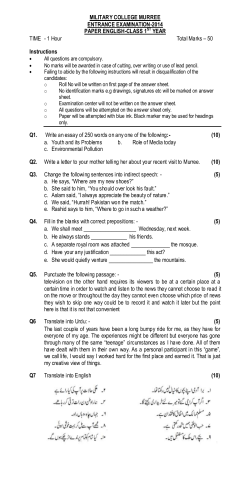
EN14 103 Engineering Physics
COMBINED FIRST AND SECOND SEMESTER B.TECH (ENGINEERING) EXAMINATION; EN 14 103 – ENGINEERING PHYSICS Time: 3 Hours Max: 100 marks PART A: Analytical/problem solving SHORT questions Answer Eight questions out of Ten (Each Question carries 5 marks) 1. What is the condition to obtain bright and dark fringes in interference? 2. What is Rayleigh’s criterion for resolving power? How to express resolving power of a grating? 3. Define Brewster’s (polarizing) angle? 4. What is mean by double refraction? 5. What are the silent features of F.D. Statistics? 6. Define spontaneous emission and stimulated emission? 7. Define acceptance angle and numerical aperture? 8. What are the properties of nanomaterial? 9. Distinguish between intrinsic and extrinsic semiconductors? 10. Write short note on HTSC? (8 x 5 = 40marks) PART B: Analytical/Problem solving DESCRIPTIVE questions Answer all questions (Each Question carries 15 marks) 11. (i) Derive time dependent Schrodinger wave equation? (ii) Explain the physical significance of wave function? State and explain uncertainty principle? Or 12. (i) Explain construction and working of Laurent’s half shade polarimeter? (ii) Explain the production and detection of elliptically & circularly polarized light? 13. (i) Describe the production of ultrasonic waves by magnetostriction method. (ii) What are the propertiesof ultrasonic waves? Or 14. (i) Discuss the theory of Newton’s Rings with relevant diagram and derive expression for the diameters of dark and bright rings. 15. (i) Describe the construction and reconstruction of hologram? (ii) Explain any 5 types of transmission losses in optical fiber? (iii) Explain the construction and working of semiconductor laser? Or 16. (i) Derive the expression for N.A., in terms of n1(refractive index of core), and ∆ (fractional refractive index change) (ii) Explain the construction and working of Ruby laser. 17. (i) Explain type I and type II superconductors with suitable example. (ii) write short notes on LED & solar cell. Or 18. (i) Derive expression for Fermi level in extrinsic semiconductors? (ii) Explain the construction and working principle of SQUID? COMBINED FIRST AND SECOND SEMESTER B.TECH (ENGINEERING) EXAMINATION; EN 14 103 – ENGINEERING PHYSICS SCHEME OF EVALUATION 1. Condition for constructive interference (2.5 marks). Condition for destructive interference (2.5 marks) 2. Rayleigh’s criterion for resolving power: explanation (2.5 marks). Resolving power of a grating: explanation (2.5 marks) 3. Brewster’s (polarizing) angle explanation (3.5 marks) Diagram (1.5 marks) 4. Double refraction explanation (4 marks) Diagram (1 mark) 5. State at least 8-10 salient features of F.D. Statistics 6. Explanation of spontaneous emission (2 marks), Explanation of stimulated emission (2 marks) Diagram (1 mark) 7. Explanation of acceptance angle (1.5 marks), Equation with correct explanation of terms (1 mark), explanation of numerical aperture (1.5 marks), Equation with correct explanation of terms (1 mark) 8. Explanation of 5 nano-material properties with example 9. State any 5 differences between intrinsic and extrinsic semiconductors 10. Explanation of HTSC with different classifications 11. (i) Complete derivation of time dependent Schrodinger wave equation (7marks) (ii) Physical significance of wave function (3 marks). Explanation of uncertainty principle in its 2 forms. (OR) 12. (i) Construction of Laurent’s half shade polarimeter with suitable diagram (2.5 marks). Working of Laurent’s half shade polarimeter with example of determination of concentration of solution. ii. Explanation of the production of circularly polarized light with suitable diagram and experiment (3 marks). Explanation of the detection of circularly polarized light (2 marks). Explanation of the production of elliptically polarized light with suitable diagram and experiment (3 marks). Explanation of the detection of elliptically polarized light (2 marks). 13. (i) Magnetostriction principle (2 marks). Circuit diagram of magnetostrictive oscillator 2marks. Description of generation of ultrasonic waves by magnetostriction method (including the construction & working of magnetostrictive oscillator) (6 marks). (ii) Explain any 5 properties of ultrasonic waves (5 marks). . (OR) 14. (i) Theoretical explanation of Newton’s Rings formation (3.5 marks). Correct diagram (Newton’s rings by reflection): (1.5 marks). Derivation of expression for the diameters of dark ring -5marks. Derivation of expression for the diameters of bright rings (5 marks). 15. (i) Explanation of the construction of hologram with suitable diagram (2.5 marks). Explanation of the reconstruction of hologram with suitable diagram (2.5 marks). (ii) State any 5 types of transmission losses in optical fiber in detail (5 marks) (iii) Explanation of the construction of semiconductor laser with suitable diagram (2.5 marks). Explanation of the working of semiconductor laser with energy level diagram (2.5 marks). (OR) 16. (i) Derivation of proof of the expression for N.A., in terms of n1(refractive index of core), and ∆ (fractional refractive index change) with suitable diagram ending in equation N.A. = n1√2∆ (8 marks) (ii) Principle and construction of Ruby laser with suitable diagram (3.5 marks). Working of Ruby laser with energy level diagram (3.5 marks). 17. (i) Explanation of type I superconductor (2 marks). Type I superconductor diagram 1 mark. Type I superconductor example (0.5 marks). Explanation of type II superconductors 2 marks. Type II superconductor diagram (1 mark). Type II superconductor example (0.5 marks). (ii) Explanation of LED with correct symbol and I-V characteristics explanation and examples 4 marks. Explanation of solar cell with diagram (4 marks) (OR) 18. (i) CFomplete derivation of Fermi level in n type extrinsic semiconductors(5marks). Complete derivation of Fermi level in p type extrinsic semiconductors – (5marks) (ii) Construction of SQUID with Working principle of SQUID (2.5 marks). suitable diagram (2.5 marks).
© Copyright 2026









